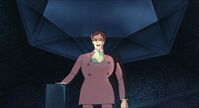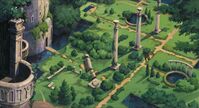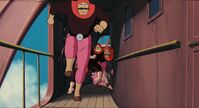In the works, Laputa is not only the name of a city, but also the name of a lost civilization. The story’s performance on Laputa is only an abandoned city, but if you look closely at the opening captions, you can find floating city clusters. This is the main feature of this civilization. Regarding the Lost Civilization, according to the few animation and game works I know, I think it is often used. For example, the two generations of Final Fantasy I have played, the seventh and the eighth generation: there is a lost civilization in the seven generations, namely "Ancients", the ancients; the eight generations show a lost civilization, namely "Esthar" by time and space. Esta. In addition, South Korea follows the Japanese style of the game "Stardust Story", which also tells the story of the advancement and decline of civilization.
In "Stardust Story", the previous advanced civilization created the "Ark" for a few "elites" to escape the doomsday trial. In the "Ark", the "elites" call themselves gods and use one station as "Elizabeth". The computer simulates another world, or another civilization. The "elite" has a love relationship with humans in the simulated world. In the end, the two civilizations crossed, the "Ark" fell, and no matter which civilization it was, human beings were also punished by God. Here, "Stardust Story" explained and used "Apocalypse", but it was unsuccessful. The whole narrative structure was very chaotic, and there were many characters in the scene but failed to help the narrative.
In contrast, the interpretation of the Old Testament in The Song of the Saint in the Wind and Thunder era is much more comfortable. The two generations of "The Song of the Saint" (the bride of the mermaid, the angel of the threshing mother) have been published, using Nordic mythology as the framework, and the struggle between humans and God's punishment as the main line, which highly praises the spirit of human struggle. Here, the advanced civilization of the past (the civilization before the punishment began) is looming, but the people living in the punishment process have not developed any adoration of the past civilization. The protagonist Edda's resistance to fate (although her fate cannot be said to be bad) is more emotional. From a slave to a mermaid princess, Edda did not hesitate to dismiss this identity change, but she was tolerant and understanding of her relatives, especially her sister. Some people say that Edda's constant search for clues to his sister Liv is the failure of "Song of the Saint", but it is precisely this emotional basis that makes Edda more humane and more human. Because in the second generation, although Edda has taken on the important task of saving the civilization of Saremu, although she can also enjoy the glory and wealth in Saremu (the second time after the mermaid princess), she still has not set foot on the east. The way home. Since there is no news of her sister in Saremu, is Tungus in the east more hopeful to find a sister? Not more hopeful, but Edda has nowhere to go. Edda broke through the illusory world under the sea, left deep regrets in his hometown, saved the water elves and wind elves, revealed his extraordinary life experience in the city of Asaph (referring to the exposure of the mermaid identity), and finally saved the entire sea. She didn't know what to do next. Is it to continue to save mankind along the route prescribed by fate, and finally sound the horn of the end of the end, or to find the only sustenance in her heart? At the end of the second generation story, the only suspense is the mysterious East, which is the only meaning for Edda to live. The Easterners threatened her and had an inestimable need for her. Compared to the city, Asaph’s need for the mermaid was insignificant, but there was nowhere for Edda to go except the East (Asaph City had already looked for it, no Sister, so it is impossible to go there). Therefore, even if there is no sequel to "Song of the Saint", we can still appreciate the meaning of life. It doesn't make sense to stay in place and accept the arrangements of fate. You must constantly move forward, toward a goal, regardless of whether the goal is ambitious or not. Therefore, it is not so much that the "Song of the Saint" is explaining the "Old Testament", it is better to say that it has established a beacon of faith for our lives.
Back to "Castle in the Sky". This work can be said to have separated the relationship between civilization and mankind. This is not a shortcoming, but a cautious proposal: mankind cannot control the endless desires. Human beings are smart, but only technically. They can achieve great civilization technically, but after civilization reaches a certain height, mankind faces a choice: to maintain current technology and wealth, and to seek to break through secular barriers spiritually Or is it to expand the influence of civilization through physics, so as to obtain a sense of dominance? Domination is a more terrifying desire than gaining wealth. We see that Mooscar (the man wearing sunglasses), one of the descendants of the Laputa civilization, was unsympathetic to the wealth left by civilization, but when he commanded the army (at that time he only had the privileges of government agents) and used technology to destroy When the army (these army no longer poses any threat to him, they are retreating, but Mooscar still sends out almost all the robots with great fanfare, it is almost anti-aircraft guns to fight mosquitoes), he has unprecedented satisfaction. If Mooscar just likes to sleep comfortably in Laputa's treasure, then we can be fortunate and come to a somewhat absurd conclusion: wealth is harmless, power is harmful.
We should note that the key flying stone is not needed to obtain wealth-the army just blasted the door of the treasure house with ordinary explosives. The functions of the flying stone in the whole play are:
1. Undead;
2. Command the robot to protect itself (but the robot is not under control);
3. Give the position of Laputa;
4. Turn on the power of Laputa;
5. Turn on the power of Laputa use.
In fact, Shita was using Laputa's power when awakening the damaged robot, because the robot is part of Laputa's power. And "giving the location of Laputa" is to allow the owner of the flying stone to open the power of Laputa, and then use the power. Therefore, in addition to the attributes of flying stones that make people undead, we can say that flying stones are a symbol of power.
In addition, looking at the structure of the city in the sky, the bottom layer is the power layer, the middle layer is the wealth layer, and the upper layer symbolizes the spirit. Towards the end of the play, Shita let Laputa destroy himself. At that time, I thought the entire Sky City would become ashes, but in the end only the power layer and wealth layer disappeared. What a fragile tree root is. Mooscar expressed dissatisfaction with the roots when he first entered the power hierarchy and threatened to burn them. Moreover, when Pasu's bravery was expressed in the play, the fragility of the roots of the tree was repeatedly described, many of which were broken at once. However, in the process of self-destruction, the roots of the tree were kept intact, and the hero and heroine were saved as a result. At this time, the camera turns to the top of Laputa again, and we see that the "life" of the only surviving robot (which is not part of power) has not been affected at all. The author may want to show that as long as the spirit of civilization is always present, civilization can exist even without power and wealth. After destroying power and wealth, Laputa rose to satellite orbit, thus possessing eternal significance. At this time, Laputa does not need storms and clouds to protect itself, and can achieve an immortal state. Our most beautiful home is built by the spirit of peace and love.
A post on a blog on the Internet said that "City in the Sky" left the post author's deepest impression on the scene where robots covered with flowers and plants live in harmony with small animals. This scene is indeed very classic, so that I thought at first that when I wrote about this scene, there was nothing new in this post. But before falling asleep that night, I quietly thought about the entire plot of "Castle in the Sky", thinking that the center of the whole play was that scene: the robot that was once a horror devil can actually appear in Niaoyuhuaxiangzhi with another appearance. It was accepted by the audience, and even moved the audience. This is not easy. If you are not moved by that scene, what meaning will this work have? This reminds me of the posts about commenting on "The Thief" DV that I have seen in the past few days. I have sneered at the author's way of writing the plot, but it is these plots that make "The Thief" shocking.
The Internet has given people a new space for communication and venting. Even people who do not have a high "literary level" and "academic level" can show their opinions before tens of thousands of faces. So, why should we demand so much of the people? To demand the common people, in a sense, is to satisfy the demanding people's desire for domination. In "Stardust Story", man's desire for dominance swells to a position to replace God; in "Sky City", man's desire for dominance can surpass the desire for money. "Stardust Story" says that God created man, and man cannot betray God; "City in the Sky" says that only when power and wealth are destroyed can eternity be achieved. Class is relative, and the masses of beings in the eyes of the Buddha are absolute and the ultimate goal. In this way we can understand why Edda is unwilling to accept his fate of saving the world. Because “saving” can only be done by God and the suffering people themselves. To save others is actually a kind of domination.
In the early morning of November 23, 2004, in the second apartment in Chengdu, the
reference material catalog:
1. (Korea) Sonnori & GRAVITY, "Acturus: The Curse and Lose of Divinity" (Acturus: The Curse and Lose of Divinity), Sinicization and agency of Yixing Software, Pudong Electronics Published by the publishing house in 2003.
2. The era of wind and thunder, "Heroine Anthem" (Heroine Anthem), agent of Universe Star, published by Beijing Yinguan Electronic Publishing Co., Ltd. in 2002.
3. In the era of wind and thunder, "Heroine Anthem II: The Angel of Sarem" (Heroine Anthem II: The Angel of Sarem), agency by Universe Star, published by Fangyuan Electronic Audiovisual Publishing House in 2003.
4. (Japan) Miyazaki Jun's original painting and script, produced by Tokuma Bookstore (1986), "Sky City" (Sky City: ラピユタ), published by Xiamen Audiovisual Publishing House in 1997.
View more about Castle in the Sky reviews











